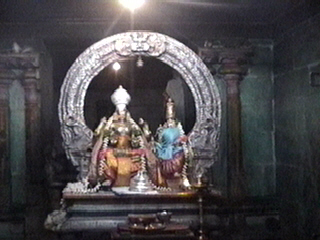Somaskanda is a manifestation of Shiva
featuring Shiva, Uma and Skanda; Shiva
in a seated posture, with Parvati to his left and with Skanda
his son, seated in between the two.
The Somaskanda manifestation of Shiva has been held in reverence in the
Tamil region for centuries. The earliest stone panels of Somaskanda of
the Pallava period date back to the 7th century CE. Most of the Shiva
temples in Tondai Naadu (around Kanchipuram)
bear a Somaskanda panel behind the Shivalingam
in the sanctum.

It was however in the Chola period
(9th century onwards) that the rich bronze images representing Somaskanda
came into being. Somaskanda is a unique concept of the Tamil region and
it represents Shiva as the Supreme Godhead (in the Saivite system of
beliefs) as a father by the side of his family, Parvati - a gracious mother full of
tenderness, and Skanda (Murugan) one of the favorite deities of the Tamil
region their son.
Interestingly in Kanchipuram, there
is no shrine to Shakti in the famed Ekambreswarar
temple; however the Kamakshi Amman temple,
the Kumara Kottam temple dedicated to Skanda
and the former comprise a Somaskanda formation, with Skanda's temple located in the middle
of the vast temples dedicated to his parents. Yet another such formation exists in the
Mullai Vananathar temple at Tirukkarukaavur
(associated with fertility).
Somaskanda - Tyagaraja
is given prime importance at Tiruvarur and
at the other 6 of the Sapta Vitanka shrines.
See also:
Somaskanda - legend at
Tiruvarur
All about Shiva
All about Shakti
All about Skanda
